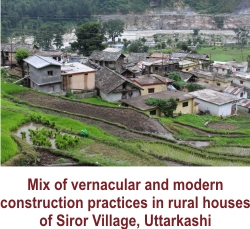|
Hazard Resistant
Construction
Hazard Prone Area of Uttarkashi Problem Statement: Vernacular or Modern Construction Practices Vernacular architecture of Uttarakhand led to construction practices perfected to suit the conditions specific to its geographical, climatic and cultural context. However, the 20th century gave rise to globalisation and the creation of our concrete cities, which tended to create an aspiration in rural areas to erect their 'pakka makaans', perceived to be stable structures. This was aided by the influx of relatively cheap and readily-available materials such as cement and the touted longevity of the same. In this process, grass-root level sustainability of vernacular practices has been adversely affected.
Habitat Assessment of Rural Uttarkashi Department of Science and Technology of the Government of India has initiated TIME-LEARN Programme (Technology Intervention for Mountain Ecosystem: Livelihood Enhancement through Action Research & Networking) in 2017. The primary focus in this programme is technology innovation in 3 states of the Indian Himalayan Region i.e. Jammu & Kashmir, Himachal Pradesh and Uttarakhand, working across 5 thrust areas (Agriculture, Biodiversity, Rural Engineering, Water Resource and Disaster Management). Development Alternatives (DA) along with its implementation partner - Himalayan Environmental Studies and Conservation Organisation, Dehradun (HESCO) and research support from DIT University, Dehradun has conducted a detailed documentation of 10 rural houses and surveyed about 100 households in Uttarkashi district. The purpose of the documentation was to understand building technologies and habitat designs in the hilly areas of Uttarakhand. Traditional Materials Stressed and New materials Lack Know- How The rural communities of Uttarkashi still retain their belief in their strong vernacular building systems which use locally-available materials like wood, stone and slate shingles (pathal). However, after the Ministry of Environment, Forest and Climate Change (MoEF) declared the Bhagirathi stretch as an eco-sensitive zone in 2012, natural resources such as wood and stone cannot be used for the purpose of building construction. As a result of this unavailability, people have turned to the use of substitute building materials like cement. Some of the findings from Uttarkashi indicate the following: 1. Unsafe use of new materials a. Ease of access of cement based manufactured products has not ensured sound construction practices in the region. b. New materials like concrete blocks are convenient but have no standardised quality. c. Reinforced concrete cement frame is practiced because of perception of strength but lacks structural continuity and anchorage. d. The local masons and builders are unaware of the basic properties of cement, its structural qualities and limitations and therefore grossly mis-designed structures have been coming up. These concrete structures are failing to provide the very thing they were planned for in their inception: safety, strength and longevity. 2. Shift to using Flat Roofs a. Flat slabs are valued for drying grains, thus there is a shift seen from traditional sloping roof design b. Attachment of flat slabs is unsafe as compared to sloping roofs Way Forward for Hazard Resilient Solutions The observations drawn from this documentation prove that the future of hazard-resistant technologies lies not in the pure vernacular, nor in the current common materials, but in a fusion of the old and the new. A new form of hybrid architecture needs to be created which respects the local building practices and uses that knowledge-base to elevate them to demonstrate strength, safety and responsibility. The sale of new construction materials and practices must be accompanied by the spread of know-how to use it. ■
Mausam Jamwal
References: |
